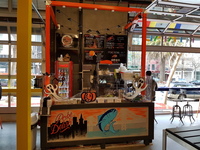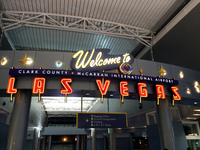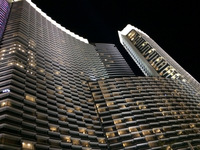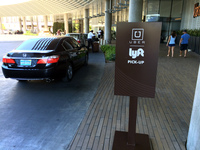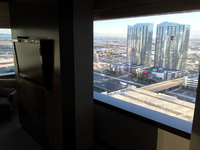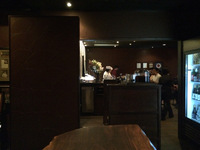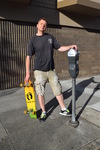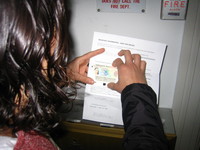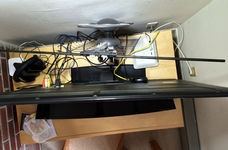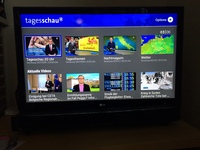 |
| Angelika/Mike Schilli |
Michael In Germany, to put a picture frame up on the wall, renters break out the hammer drill, to go through common brick walls like butter, then insert a plastic anchor in the hole and a screw, and up goes the frame, solid as a rock, forever and a day, regardless of what happens around it. Not so in America, where most houses aren't made of bricks, but built by nailing half-inch-thick slates of drywall onto wooden 2x4 studs and calling the result "house" (figure 1). You might think I'm pulling your leg here, but that's the honest truth. It's done this way mostly because it's cheap, but in the San Francisco Bay Area it's actually a safety measure, because of the constant earthquakes. Wood is flexible and bounces back, while bricks crumble and crush occupants.
You can imagine what happens to a picture frame hanging by a single nail sticking in a half-inch thick cardboard: It won't last long on the wall and will drop sooner or later when the nail loses its grip. Living in such a house of cards, instead of simply driving the nail into the drywall, you need to find the vertical wooden stud the drywall was nailed onto, to drive the nail through the drywall and right into the wooden stud, where it sits rock-solid. But how do you find these studs, which are hidden invisibly in the wall, spaced out with 16 inches in between them? You can't look through the drywall, obviously, but this is the country of great inventions, which is why you can find gadgets at every hardware store to solve the problem.
So-called "stud finders" probe the wall and light up when they detect a stud inside. The electrical variant works similar to a metal detector and starts blinking if the location is suitable for driving in a nail or screw. However, less commonly known, but a lot cheaper and even more effective are magnetic variants of the tool. They make use of the fact that studs usually contain metal nails spaced out evently, after all, someone must have nailed drywall sheets onto them when the house was built. These magnetic tools don't need a battery, they simply use a strong magnet which gets pulled towards metal in the wall, making the tool stick to the wall in locations where there's both a nail and a stud underneath. Genius! And it's very handy if you want to mark the stud location with a pencil on the wall. Since you don't know how far the nails are up or down the stud, drawing S-figures with the tool will sooner or later reveal a nail, and therefore the location of the stud it was hammered into. Now another nail or screw can be hammered into the wall above or below the trigger location and it is then guaranteed to land in the sturdy stud and not some loose piece of drywall.
I can recommend two devices I've had good success with: The Franklin ProSensor 710+ is quite expensive at \$50, and therefore only within reach for high rollers like myself, but I like its row of LEDs and how some of them light up in a moving pattern while you move over the wall, indicating where the stud is located at. But really all you need is a magnetic stud finder which only costs around \$10, like the "CH Hanson 03040". As the tool sticks to the wall when it finds a nail, you can use its sides as a ruler while you mark the position with a pencil, or start drilling right away. Stay away from devices made by "Zircon", I've found that they give lots of false positives and the correlation between the device blinking and a stud being present is random at best.
Michael When our dermatologist recently cut out a mole next to my hairline and left an astonishing big hole, she also handed me a sample package with some balm, and told me to apply it to the wound a few times a day. I followed the instructions to the letter and witnessed with surprise that the hole healed within a few days in such an amazing way so that I could hardly tell where it had been before.
"I'll be damned", I thought to myself, "that must be a new miracle balm, could it be, that after thousands of years of ongoing research in the field of balms and ointments, we're now all of a sudden lucky to witness a significant medical breakthrough?" It certainly seems like it, because when I recently fell off my skateboard, and routinely swiveled around in the air like a cat to land on all four paws, and suffered a bad scratch on the palm of my hand, I immediately applied the miracle balm to it when I got home. Three days later, the wound had healed perfectly without leaving a scar. This new killer ointment simply blows regular American balms like "Neosporen" right out of the water. It's called "Aquaphor" and it is not only recommended by leading dermatologists, but also by myself with my somewhat, erm, active lifestyle. Rumor has it that Aquaphor is made by a German company, well, what a surprise!
Angelika A while ago, we reported on a traditional Hawaiian raw fish dish, called "Poke" (Rundbrief 09/2013), which is so common on the islands that every supermarket offers it in their fish section. Apparently, word has gotten out that Poke is delicious and even healthy, and still has a touch of exotic flavor, as Poke places are popping up like mushrooms in San Francisco. In our close neighborhood alone, there's two new shops offering "Poke Bowls". Those are tiny places, comparable to mom and pop takeout places in Germany. Seating is strictly limited, and there's no table service, instead customers order directly at the counter.
This particular location let us customize our Poke bowl. Traditionally, on Hawaii, it comes with a bed of rice, topped with the raw marinated fish. When we ordered Poke bowls at "Poke Delish" in the Castro neighborhood, we were able to choose between rice or salad, and three different kinds of fish in combination with various sauces. Up to three different selections were permitted, and finally various toppings, like green onions, sea weed salad, pickled ginger, flying fish roe (Tobiko) and Edamame. We both enjoyed our Poke bowls! I'm not sure how many Poke locations can coexist in the city while still making a profit, and how long the trend will continue. But even if it goes out of style one day, we'll still have Hawaii, where Poke is part of the culture and will live on forever.
Angelika Attentive readers of this publication already know that many many years ago, Michael and I met in a car rental agency in Las Vegas, and since this year we're celebrating a very special anniversary, we returned to the glamorous city in the desert on this occasion. Las Vegas has been constantly reinventing itself over the years, and therefore has changed quite a bit from the olden days. Yesteryear's cheap hotel paradise with all-you-can-eat buffets galore made room for luxury resorts and gourmet restaurants. Of course, there's still plenty of casinos around, but those apparently aren't the gold mines they used to be anymore, and so the entertainment industry tycoons there have invented new ways to separate tourists from their hard earned dollars.
There's an ongoing theme in the money-grubbing game played by the casinos lately, and it's to take money for the most ridiculous things. You might be familiar with this scheme when flying major US airlines: Paying for checked in luggage, extra fees for seats with more leg room, non-free meals on domestic flights, or paying for the privilege to pick your own seat on international Lufthansa flights to avoid getting assigned a random one. But who wants to be squeezed into the middle seat of a row of five on a 12 hour flight? There's lots of moaning and gnashing of teeth, but in the end, customers pay up.
Most hotels on the Las Vegas Strip have been charging the so-called resort fee for quite a while now. They're slapping between $20 and $32 per night onto the room bill without actually providing value for the customer, because hardly anyone uses the pool, the fitness center oder the spa. And guests have no choice anyway, because the fee is mandatory for all guests, whether they ever set foot in those areas or not. Hotels could of course just as well add the fee to the published price for the room per night, but they'd rather advertise a lower price and then add hidden fees when customers click to buy.
My guess is that major Las Vegas Casinos are employing armies of bean counters whose only job it is to invent new fees for guests who grudgingly just pay them because they have no other choice. And, low and behold, last time we were in Las Vegas in September, the first Casinos started charging for parking. Until then, the Casino mantra appeared to be to focus on attracting as many guests as possible, by making their arrival as easy and swift as possible. Both valet and self parking were free of charge for that reason.
Since June 2016 guests have been paying between $8 and $10 per day for self parking, and $13-$18 for valet parking at the MGM group casinos Aria, Bellagio, Circus Circus, Exalibur, Delano, Luxor, Mandaley Bay, MGM Grand, Mirage, Monte Carlo, New York New York, and Vdara. On self parking, the first hour is free, however, until now. Also, residents of Nevada get a free pass until the end of this year. It remains to be seen if other casinos follow suit, like those of the Wynn group. I'm afraid that they will. As we've seen with air travel luggage fees, it's always the competitor with low advertised prices and hidden fees that makes the deal.
AngelikaAs you know, we are great fans of Japanese cuisine. I personally could eat sushi or other Japanese delicacies every single day, to the point where Michael readily complains: "Sushi, again?!" Now, we are somewhat spoiled with an abundance of sushi or Japanese homecooking available in San Francisco, and restaurants in Las Vegas are hopelessly overpriced. This is why we're often drawn to off-strip locations during our yearly visit, as these restaurants in different Las Vegas neighborhoods offer better food quality for the price.
Michael's colleague at work had been raving about a Japanese place called Raku, located in an undescript mall on Spring Mountain Road in the Spring Valley neighborhood. We had to try it out and took a Lyft cab for the 10 minute ride. Raku offers an excellent variety of delicacies, mainly scewers from a wood-fired grill (yakitori), sashimi, but also home made tofu. We had grilled pork cheek scewers, raw kobe beef liver, a poached egg with Uni (sea urchin), and ikura (salmon roe). Raku isn't exactly cheap either, but the amazing quality of all dishes served was well worth every penny. It's still mouth watering when I'm thinking about it now.
Michael Every Thursday during lunch break, our entire department takes off to go eat at a different cafeteria, every team member riding on a skateboard, closely following our manager through various Silicon Valley parking lots and side streets. As you might know, I'm always game when it comes to fun activities, even at my advanced age, so I spent $100 on a so-called longboard at a skate shop and have been participating in Thursdays' lunch ride.
Many many years ago, as a teenager, I had aquired a skateboard, ironically priced at 100 Deutsch Marks, and therefore I already knew the dangers of rolling on asphalt: Stray small pebbles can lock up the wheels, bumps can make you loose your balance and let the board swoosh away from right under you, and before you know it, you've landed hard on the street, on your hands and knees. In comparison, surfing in the ocean is much softer when you fall, hitting concrete can be downright dangerous and very painful. I learned that despite the dangers, it is a total no-no in California to wear any kind of protective gear, even kids hitting the half pipes in the skate parks have totally abandoned the once popular helmets or knee, wrist, and elbow pads.
Thursday mornings, I often ride my skateboard to the company shuttle bus stop in San Francisco, which is about half a mile from our place. First, there's a steep downhill on 24th Street, where I carry the board, although I've seen a few clearly insane people just bombing down in traffic. Our city has specific traffic laws for skateboarders, according to the San Francisco traffic code, skateboards fall into the "NUV" category, meaning "Non-motorized User-propelled Vehicles", a device with "two or more wheels lacking a belt, chain, or gears", which is being propelled forward by "pushing off or kicking at the ground" (Figure 16).
Furthermore, section 7.2.13 lines out that it is illegal to ride a skateboard in "business districts", or, in general, all over the city later than half an hour after sunset. Aside from those exceptions, skateboarding is legal on the sidewalk, the bike lane, and even on the street, under the condition that there's no "endangering the safety of people or property".
Unfortunately, many skateboarders here don't obey the law, bombing down steep hills in the middle of night in dark clothing, using private building structures as ramps, or clinging onto driving cars, hiding close to the rear wheel well, so that drivers won't notice -- just like Michael J. Fox in the movie "Back to the Future".
And since we're living in the most innovative place on earth here, there's no surprise that skateboard technology has advanced even further: For quite some time now, hipster youth can be seen zooming around on battery powered "Boosted Boards". Riders hold a remote control to accelerate the motor or apply the brakes. At about 20mph, they gain almost frightening speed, can climb up hills, and it's even possible to comply with traffic rules when coming to a complete halt at stop signs and to effortlessly and quickly accelerate again shortly after. Ironically, I've heard on public forums recently that these electric board riders are complaining about being ostracized and yelled at by motorists and even normal skateboard riders. Apparently this new mode of transportation is considered to be hipsterish and unsportsmanlike.
Michael If you ask ten Americans if Greencard holders pay taxes, I'll bet you that seven will answer "no", because they're completely retarded. I'm not sure why it's not common knowledge that everyone living in the US for more than six months must pay taxes here, just like ordinary Americans, and not only on their US income, but on their world wide earnings! Now, if taxes are the same, what's the difference between Greencard holders and citizens?
After all, a Greencard holder can stay in the country indefinitely and may work in any job with any employer -- except those that require special security clearance and citizenship, e.g. with the department of defence. After ten years, a Greencard will expire, but it can simply be renewed to the tone of a $450 processing fee.
A real bad downside of being a Greencard holder as opposed to being a citizen is that the card actually becomes invalid once the holder stays abroad for more than a year without getting special permission from the immigration department, which might extend the permissable stay abroad to at most two years. Naturalized citizens, in comparison, can come and go as they please.
Another disadvantage for Greencard holders compared to citizens are different tax exemptions as a heir of financial assets or real estate. Admittedly, this only affects wealthy families, as heirs with citizenship only have to pay the so-called estate tax if the total value exceeds roughly five and a half million dollars ($5,450,000 to be exact). Marrieds couples can even double that amount if they pass on their wealth to another citizen. If one passing citizen passes assets on to their spouse, the tax-free amount is even unlimited. But watch out, if the spouse is a Greencard holder without citizenship, they'll totally pay estate tax on amounts exceeding $5.45M! Gifting during lifetime is subject to even stricter rules. A Greencard holder can "only" receive amounts up to $148,000 per year tax free (as of 2016), and will pay taxes on anything exceeding this amount. Long story short: If a married couple has more than five Million Dollars lying around, they should definitely become citizens, otherwise death will cost more than their lives!
On top of that, Greencard holders cannot vote or sit on jury duty. If a request comes in by mail, citizens are required to spring into action and are heading towards the justice building, while Greencard holders may remain seated on the couch, while sending back the letter with the appropriate box checked (Rundbrief 09/2002).
Greencard holders are obligated, however, to join the United States army in times of war. Personally, I've been known as a jarhead since my army days, and I would no doubt instill great fear into the enemy, even nowadays, at my advanced age. After seven years, Greencard holders are required to submit income tax declarations for ten years to the United States IRS, even if they decide to go back to their home country or move somewhere else at some point. This is even true for citizens, by the way: Regardless of which country they decide to relocate to, the United States IRS requires yearly income tax declarations, listing meticulously what was earned and where taxes were paid. Indefinitely.
Then there are legal situations where a US citizen enjoys better protection than a Greencard holder, for example when a married couple uses a surrogate mother to have a child. In Germany, this practice is illegal, in the United States, it is legal, so obtaining US citizenship provides the required legal framework. Or take the case where a same sex couple wants to adopt a child. This doesn't work yet in Germany, but it is common place in the United States. As soon as the couple obtains US citizenship, however, German bureaucrats will change their minds and accept the adoption.
If German citizens decide to become US citizens, for what reasons whatsoever, they should file a request to keep their German citizenship before applying. Why? As soon as German officials find out that one of their own citizens has obtained a foreign citizenship, they'll abruptly cut their ties with them by relentlessly stripping them off their German passport. But if the applicant filed to keep their German citizenship beforehand, the German consulate might agree that taking away the German passport would be an undue burden on the applicant, e.g. because they still have strong ties to their home country or apply for the foreign citizenship because their job requires it, and therefore have no choice. Assuming the German consulate says "ja" to keep, and Uncle Sam says "yes" to obtain the new citizenship, the newborn American will carry two passports from then on, using the appropriate one to enter either country.
There's one more catch, though: As soon as a German citizen obtains US citizenship, regardless of whether they were permitted to keep their German passport or not, the German consulate will no longer help out these hybrid Germans when they get in trouble in the US. Regular German citizens can always count on calling the consulate, day or night, if they need help, but the consul refuses to help US citizens. And according to rumors (some of which I might have started circulating myself), he will instead return a post card with a humorous motive and the imprint "Good luck with that, buddy."
Angelika It's commonly known that there's a two party system in American politics. There's Democrats, currently represented by Hillary Clinton, and Donald Trump, running for the Republican party. But candidates of both partes are polling at an all time low in public opinion.
Many voters who have been supporting Republicans for many years, regardless of who was running at the time, cannot get themselves to vote for Donald Trump, but don't want to see Hillary Clinton move to the White House either. You can imagine that this is quite a dilemma. On the other hand, there's many Democrats who dislike Hillary Clinton, but would under no circumstances vote for Donald Trump. What to do? These voters can choose between either staying home, to forfeit their voting rights, or give their vote to one of the third party candidates Gary Johnson or Jill Stein, neither of whom has any chance of winning the presidency. Also, votes for these candidates decrease the number of votes for the mainstream candidates Hillary Clinton and Donald Trump, so third party voters can dramatically influence the outcome of the election. In the end, it's a form of protest to vote for a third party candidate in the United States.
Gary Johnson used to be republican governor of the state of New Mexico, but now decided to run as a Libertarian. He wants to get rid of income tax and Obamacare, is aiming for a balanced budget and reducing the influence of government. He is also opposed to both U.S. military in foreign countries and regulating the Internet.
Jill Stein, who is a doctor, running for the Green Party, focuses on environmental topics: renewable energy, build out of public transportation.
As I've said before, none of these alternative candidates will even have the tiniest chance of winning, but both remind me of the debacle with Ralph Nader back in 2000, when, in all likelihood, Nader's campaign as an outsider cost Al Gore the election. Nader received critical votes in Florida needed by Gore, propelling the republican George W. Bush into office.
AngelikaTV debates between Hillary Clinton and Donald Trump are agonizing to watch. Both of them keep repeating the same old sound bites, Clinton maybe a bit more nuanced, but they're still insufferable. It is as if the entire country has been taken over by loudmouths who don't have enough material to debate a given topic for more than two minutes.
But there's still hope, as since 1991, journalist Charlie Rose has been procuding a moderating the "Charlie Rose" talkshow. Public television station PBS ("Public Broadcasting Service) and Bloomberg TV are airing the show Monday through Friday. Usually, Rose spends about an hour talking to a guest, sometimes it's even two or three. He invites all kinds of people, politicians, Nobel Prize winners, doctors, athletes, authors, actors, or musicians. Last week, for example, he had Jeff Bezos (Founder of Amazon), golf player Tiger Woods, actress Sarah Jessica Parker, conservative opinion piece writer Glenn Beck and Prince Zeid Ra’ad Al Hussein of Jordan.
You'd be mistaken if you assumed all that was happenting was superficial chit-chat. Rose asks smart questions and his guests usually provide thoughtful answers. Also, the format is quite diametrically different from typical talk shows, where people keep yelling and speak out of turn. Instead, Charlie Rose and the guest are sitting on opposite sides of a round oak table, with a pitch dark backdrop, and focus on their dialogue.
There's nothing except these no-frills requisites, the oak table and the dark backdrop, which have since become the trademark of the show. The set was originally designed this way for rather pragmatic reasons, however, because Rose had very little production money available in the beginning and simply purchased the table himself. For myself, I can say that I entirely enjoy almost every episode and can only warmly recommend the show to others.
Michael The Bay Area cable TV de facto monopolist Comcast, known for continuously hiking their montly fees, has lately drawn some consumer criticism. They're offering Internet and cable TV service as low as $50 for new customers, only to increase the price to $150 six months later. You've got that right, Americans are paying $150 per month for Internet and cable access, while it's often less than $50 in Europe. It's the result decades of failed politics, granting a price gouging monopolistic company free reign, as we've outlined in a previous issue (Rundbrief 12/2010).
But there's a growing number of Americans who are fed up with overpaying for cable, who've set out to cut ties with their providers, under the banner "Cut the Cord". That's not hard to do, as aside from cable, Internet can be had through the telephone as DSL, or via a separate fiber line, and even for cable TV there are a few perfectly legal options without going through monopolistic providers like Comcast.
There's a steady inflow on Amazon of books dealing with guides to "Cut the Cord", and even my hygienist recently quizzed me about the possibilities while polishing my choppers. As many of our readers know, I'm usually ahead of the technical curve, compared to the rest of mankind by two, three years, and have indeed discontinued cable service three years ago. Ever since then, whenever I drive by our Comcast store, I give them a nice wave and burst out laughing.
But luckily, we're located here directly in the eye of a technology hurricane, with plenty of hungry whippersnappers constantly inventing new gadgets, trying to blow dinosaurs like Comcast out of the water. It is indeed quite simple to legally receive free TV programs in the Bay Area. Today, I'm going to open the curtain to show how this is working for us. First off, there's local TV stations, broadcasting evening news and maybe a baseball game, or political content on stations like KQED who make TV programs with balanced reports and interviews for the few people around here who haven't completely lost their minds yet.
Apparently because receiving TV programs is some form of basic human right, select broadcasting stations offer their programs as digital TV through the airwaves, sent to the users' home antennas (OTA=Over the Air). Just like in Germany with DVB-T this isn't your grampa's snowy TV reception, with scrolling pictures, requiring the occasional signature whack onto the top TV with the flat hand to stop. OTA is digital, so it either works perfectly or not at all. As you might know, our location in San Francisco is very close a widely visible broadcasting antenna called "Sutro Tower", at the top of the "Twin Peaks" hill close to the geographic center of the city. After rummaging through Amazon's antenna section and reading the reviews, I finally settled for one that cost $80, and placed it behind our TV (Abbildung 24. The reception is quite good, not only from stations broadcasted from Sutro Tower, but also those coming in from San Bruno, which is 20 miles further south.
Now, as a self-respecting person with a job, without lots of idle time to lounge on the couch all day long, you might find watching TV in the U.S. very annoying and a waste of your personal time, since the stations keep interrupting their programs every few minutes to broadcast commercials. For this reason, if you decide to cut the cord, the first thing you need is a digital video recorder to tape programs and skip over commercials at the push of a button. I've been using a so-called TiVo since it came out about 16 years ago, and have been a loyal customer until today, even upgrading to a newer "TiVo Roamio" a few years ago, an astounding machine with six separate TV tuners all able to record programs on different channels at the same time (Figure 26).
You tell the TiVo which programs to record, without having to deal with start times or channels, just by entering the name of the show. It then finds out when those TV series or news shows are being broadcasted and where, and simply records them all. With this setup in place, you'll never watch live TV anymore, instead, there's twenty shows to choose from when you come home, dutyfully selected during the day and recorded by your TiVo, ready for your consumption, even when the recording is still in progress, with a quick way to skip any commercials on the way.
We're trying to stay informed on world politics and in particular keep up to date with what's going on in Germany, which is why we watch the German 8pm news show "Tagesschau" almost every single day. For this, we're using a streaming device called "Roku", which is similar to an Apple TV or an Amazon Fire, both of which we happen to have connected as well. It takes the Roku about ten seconds to start the video stream and the quality is similar to what you'd expect in Germany with your cable provider (Figure 29).
With so many electronic gadgets connected to the TV, it just happens that every once in a while, one of them stops working and needs to be rebooted, and because the cabling in the TV cabinet is somewhat confusing, I've added a switchboard with ten labeled buttons providing power to the different devices. In case a reboot of a particular device is required, Angelika can find the laser printer labeled switch on the array that looks like it came from professional audio studio, and toggle it to switch power of a specific device off and on again, in order to restart it and jerk it back to life. Sometimes she will complain nevertheless about our entertainment system being in a constant state of disarray, because it just happens that every so often, I replace a perfectly working gadget with a brand new unreliable one, which is when I tell her: "The only constant is change!".
Greetings from the country that creates new things non-stop:
Angelika und Michael





